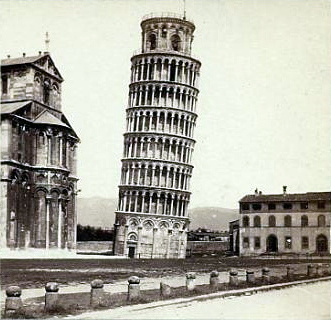
Towers of Physics
August 12, 2011 Would Pisa, Italy, be known to anyone outside its region if it were not for its famous leaning tower? And would this tower be known that well except for the famous experiment on falling bodies by Galileo that's usually depicted in one cartoon or another? In actuality, the tower experiment may have been just a thought experiment of Galileo's, but it was written as if it had actually occurred by one of his disciples, Vincenzo Viviani. Galileo, himself, wrote no record of such an experiment, perhaps because the result, that lighter objects fall just as fast as heavier ones, was contrary to what Aristotle had written. Aristotle was considered by the Church as the authority on all scientific matters that didn't contradict the Bible. Aristotle's philosophy was the official philosophy of the Church in Galileo's time, and if your science wasn't found in Aristotle, too bad for you, observational evidence notwithstanding.[1] | The Leaning Tower in Pisa, Italy. This is the right image from a stereography, dated January 24, 1866. The tower did not lean as much in Galileo's day. Photograph by Enrico van Lint (1808-1884), via Wikimedia Commons. |
"The question whether a sphere falling from rest through a few hundred feet of still air swerves perceptibly towards the south, from the vertical path indicated by the plumb line, is not, perhaps, one of the largest or more urgent problems of physics; but it has the dignity of venerable ages and the charm of mystery. It was familiar to Newton; it has been answered in the negative, on theoretical grounds, by Gauss and Laplace, and in the positive, on experimental grounds, by nearly every one of the investigators who have from time to time through more than two centuries made the actual trial."[2]In his experiment, Hall dropped 948 one-inch metal balls through a distance of about twenty meters inside the left tower of Harvard University's Jefferson Laboratory, pictured below. He found a 0.149 cm eastward deviation, which was slightly less than theoretical calculations, but assumed to be correct within the experimental error. The southwards deviation that his experiment was designed to find was 0.0050 cm, or just about his experimental error. Hall's paper states no conclusion on the matter of southwards motion.[3]
 | The left tower of the Jefferson Laboratory, Harvard University, as it appears today. Hall's ball drop experiment and the Pound-Rebka experiment were conducted here. Photo by Lubos Motl, via Wikimedia Commons. |
 | Eratosthenes (Via Wikimedia Commons). |
References:
- Aristotle (384-322 B.C.E.)
- Edwin Hall, "Do Falling Bodies Move South - Part I," Physical Review vol. 17, no. 3 (1903), pp. 179 - 190. (Search Google Books for a free version of this volume. The ads in this 1903 volume of Physical Review are entertaining, also.)
- Edwin Hall, "Do Falling Bodies Move South - Part II," Physical Review vol. 17, no. 4 (1903), pp. 245 - 254. (Search Google Books for a free version of this volume. The ads in this 1903 volume of Physical Review are entertaining, also.)
- Anders O. Persson, "The Coriolis Effect: Four centuries of conflict between common sense and mathematics, Part I: A history to 1885," History of Meteorology, vol. 2 (2005), p. 1ff.
- Paul Horowitz, "Obituary-Robert Vivian Pound," Physics Today, vol. 69, no. 9 (September, 2010), pp. 65f.
- R. V. Pound and G. A. Rebka, Jr. , "Apparent Weight of Photons," Phys. Rev. Lett., vol. 4, no. 7 (1960), pp. 337–341
- Physical Review Focus, "The Weight of Light," July 12, 2005.
- Edwin Hall, "Do Falling Bodies Move South - Part I," Physical Review vol. 17, no. 3 (1903), pp. 179 - 190. (Search Google Books for a free version of this volume. The ads in this 1903 volume of Physical Review are entertaining, also.)